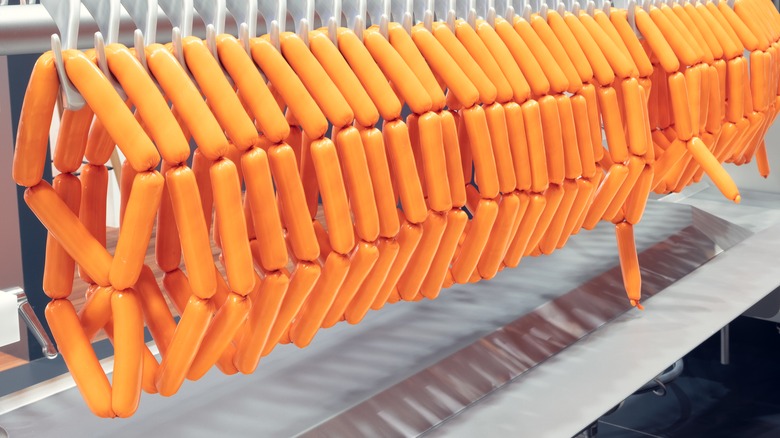What Are Hot Dogs Actually Made Of?
Fresh from the grill, at a ball game, or from a stall on the street, hot dogs are a quintessentially American bite and a wonderful party pleaser. Easy to buy in bulk and affordable (sometimes worryingly so), hot dogs have attracted skepticism from the start of their popularization.
As food historian Bruce Kraig (author of "Hot Dog: A Global History") and etymologist Barry Popik both explain to Time, the weiner's Americanized name is believed to have been coined as an amalgamation of cartoons and songs in the 19th century. First as urban lore, and later put into print in a Yale magazine, people circulated deriding satires implying dog meat was stuffed into the casing. Although it's unlikely dog meat was widely sold in the U.S., there is some credence to associations with dachshunds and hot dogs past their resemblance in shape. In medieval times and during wartime famines, dog consumption was known to have occurred in Germany, and the dachshunds were said to be the most tender, as shared in an article about a 1940 German decree published by Time.
But don't let these historic associations disturb you — there's no need to worry about what's in your modern hot dog. Meat scientist Dr. Janeal Yancey assured Best Food Facts that even the cheapest, most widely distributed sausages are made of common proteins.
Hot dogs are a cured meat product
Hot dogs are composed of meat with flavorings, preservatives, binders, and a medley of food additives, according to the National Hot Dog and Sausage Council (NHDSC). Despite the extensive list of potential ingredients, they're not there to disguise meat but actually to improve food safety. Take nitrites, which Dr. Yancey explains is where hot dogs get their distinct hue, per Best Food Facts. Although some eschew them, nitrites are not detrimental to health but rather used in hot dogs to prevent botulism.
As for the meat in hot dogs, they're generally made with trimmings from steaks, roasts, tenderloins, and other cuts that can't be packaged and sold separately. A great application of nose-to-tail eating, consuming such scraps can make animal consumption more sustainable. Which type of meat used depends on which type of hot dog you get: an all-beef ballpark dog will of course contain beef, while a chicken sausage would be made with chicken. The cheapest franks typically use mechanically separated poultry, a method of removing tiny scraps of flesh attached to bones. Though it may sound a little concerning, this product is regulated and contains higher calcium levels than other poultry meats. Additionally, don't worry about organs unknowingly being thrown in the grind; if any organ meat is used in a hot dog, the NHDSC says it'll appear on the ingredient list.
So no need to worry, your hot dog is simply meat and a few other ingredients, all listed clearly on the packaging.

